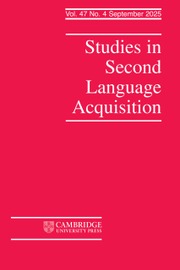Article contents
TESTING THE OUTPUT HYPOTHESIS
Effects of Output on Noticing and SecondLanguage Acquisition
Published online by Cambridge University Press: 01 September 1999
Abstract
This study addresses one of the functions of output proposed by Swain (1993, 1995, 1998).In particular, the activity of producing the target language may, under certain circumstances,prompt L2 learners to recognize some of their linguistic problems and bring to their attentionsomething they need to discover about their L2. Two research questions were posed: (a) Doesoutput promote noticing of linguistic form? and (b) Does output result in improved performanceon the target form? In treatment phase 1, participants reconstructed a short passage after beingexposed to it, followed by a second exposure to the same input material and a secondreconstruction opportunity. In phase 2, participants wrote on given topics, followed by thepresentation of a model written by a native speaker. Participants wrote a second time on the sametopic. To test the noticing function of output, participants underlined parts of the sentences theythought were “particularly necessary” for subsequent (re)production. The controlgroup was exposed to the same input materials but was not required to produce any output.Although phase 1 tasks resulted in noticing and immediate incorporation of the target form, theposttest performance failed to reveal their effects. In contrast, phase 2 tasks resulted inimprovement on posttest 2. The results are discussed in terms of the efficacy of output inpromoting noticing and learning and the conditions that may be required for output to be usefulfor SLA.
Information
- Type
- Research Article
- Information
- Copyright
- 1999 Cambridge University Press
- 97
- Cited by

